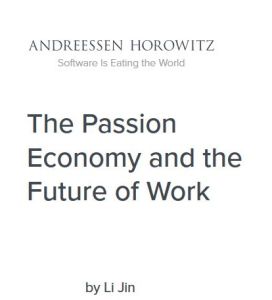Join getAbstract to access the summary!

Join getAbstract to access the summary!
Li Jin
The Passion Economy and the Future of Work
A16Z, 2020
What's inside?
Personality plus passion equals money.
Recommendation
“Being your own boss,” has long been a siren song for traditional nine-to-five workers. When the gig economy emerged, platforms like Uber took care of the grizzlier bits of working for oneself – like customer acquisition – so workers could focus on setting their own hours and getting the job done. But the gig economy generally leaves personality out of business. Is there a place for entrepreneurial creatives to monetize their products, services and personalities to create lasting income? Li Jin directs your attention to the “passion economy” in this article from venture capital firm Andreessen Horowitz.
Summary
About the Author
A consumer investing partner at Andreessen Horowitz, Li Jin is interested in new technologies, online marketplaces and early-stage consumer investments.

















Comment on this summary